Syracuse State School
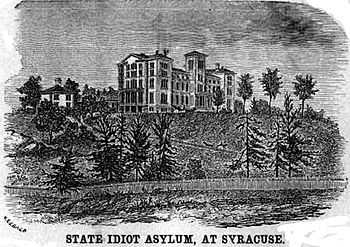
The Syracuse State School was a residential facility in Syracuse, New York for mentally disabled children and adults. Founded in 1851 in Albany, New York as the New York State Asylum for Idiots, acting upon a recommendation contained in the 1846 annual report of the New York State Asylum for Lunatics. The first director was Hervey B. Wilbur, a student of Edward Seguin (another of Seguin's students was Maria Montessori).
In 1855 the facility moved to a new building in Syracuse where it was known as the New York Asylum for Idiots or the State Idiot Asylum. Over the next hundred years the institution went through several name changes, including the Syracuse State Institution for Feeble-Minded Children, the Syracuse State School for Mental Defectives, and finally the Syracuse State School in 1927. The school was closed in 1973 and the building was torn down in 1988.
History
.png)
The New York State Asylum for Idiots was authorized by the New York State Legislature in 1851. Hervey B. Wilbur, M.D., was appointed the first superintendent and remained in that position for 32 years until his death in 1883.[1]
When the school first opened it was located in Albany, New York and the first pupils were admitted in 1851.
The rules stated by 1888 that children between the ages of seven and fourteen, who were idiotic, or so deficient in intelligence as to be incapable of being educated at any ordinary school, and who were not epileptic, insane or greatly deformed, were allowed admittance by the superintendent, "with the advice and consent from the executive committee."[2]
Syracuse facility

The cornerstone for a new facility in Syracuse was laid in 1854 and the new institution opened in 1855[1] at a total cost of $73,000. Another $13,000 was appropriated for furnishings. Approximately fifty students were present at the institution and applications had been received for another fifty more. The appropriation made, however, would only cover about 75 for the coming year.[3]
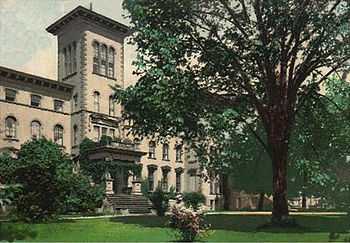
Administration and trustees
On February 11, 1885, George F. Comstock and Robert Aberdeen were assigned as Trustees of the Syracuse Idiot Asylum by the New York State Legislature.[4]
Edward Seguin Van Duyn, M.D. (1872–1955) was administrator of the Syracuse State School from 1904 until his death in 1955.[1]
Geddes location
The site selected was about a mile southwest of Syracuse, in the town of Geddes, and was "one of the finest that could have been found in the State of New York." The building was constructed of brick, "plain but substantial, and admirably fitted for the purpose for which it is designed."[3]
The institution was located upon the eastern slope of the range of hills in the western part of the city and about 1-1/2 miles south of the head of Onondaga Lake.
The asylum grounds covered an area of about sixty-five acres, immediately adjacent to Burnet Park, the most of which was high land, overlooking the city and lake. The principal group of buildings, which were clustered around the original structure, facing the western extremity of Seymour Street, accommodated about 450 individuals.[5]
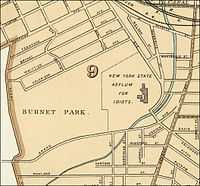 Map of Syracuse Idiot Asylum on Wilbur Avenue in Ward 9 of Syracuse, New York in 1874 |
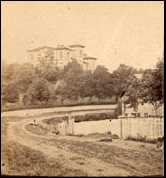 Syracuse Idiot Asylum on Wilbur Avenue in Syracuse, New York about 1890 Main Building |
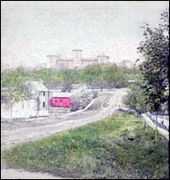 Syracuse Idiot Asylum on Wilbur Avenue in Syracuse, New York about 1900 Main Building - View from Seymour Street |
Purpose
According to administrative officials in 1855, "The Idiot Institution is more properly a school than an asylum. No immates are received beyond the age at which instruction is usually available, nor any who do not seem likely to profit by it."[3]
Like asylums for the mentally ill, the state-run schools for children and adults with cognitive disabilities found across the United States from the 1850s until the 1990s were usually self-contained communities as isolated from society's mainstream as prisons are today.[6]
The school opened in 1851 with about 30 students; the population doubled by 1853. There were 250 students by 1878 and 850 by 1922.[6]
By 1888, there were 208 males and 200 females enrolled at the institution, for a total of 408. Annual cost for the maintenance and instruction of pupils, including all expenses except clothing, and "coal supply for the ensuing year" was $71,202.42. The average weekly cost of maintenance and instruction of pupils including clothing was $3.56 per student.[2]
Facilities
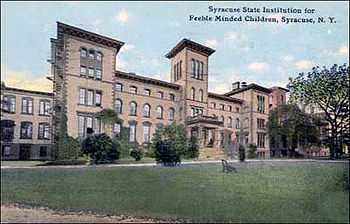
Many construction improvements were made in 1888. The trustees reported that special appropriations, totaling $27,000 had been used to erect a detached brick hospital building, a new laundry building and its equipment, an extension or addition at the rear of the boy's building and a new barn, stable and wagon-house.[2] The "school and dormitory" constructed that year were designed by Charles Erastus Colton (1847–1914), prominent Syracuse architect.[7]
The barn was a frame building 75 feet (23 m) by 50 feet (15 m). The grounds about it have been "beautifully graded and sodded and the driveway graveled, so that altogether now a happy contrast with the old structures which formerly occupied its site is presented."[2]
The hospital building was located "on a line about twenty rods south of the east extremity" of the girl's building and equidistant from the west end of the new laundry building. It was a two-story brick structure with bed accommodations for twenty patients, ten on each floor. The first floor consisted of a hospital ward for eight beds, two single rooms for sick patients, a nurse's room and bathroom. The second floor housed a single room as well as a kitchen and dining room.[2]
The new laundry building was also a two-story brick structure and was erected over the boiler and engine room, and attached to what was formerly the amusement hall, but was later converted into the ironing room. The laundry floor was laid with tile and so graded that the water ran off under the washers into a common drain to the sewer. It was equipped by Hospital Supply Company of New York, New York with their latest machinery, consisting of six metallic washers, two centrifugal wringers, and an endless chain elevator or carrier for lifting the clothes after passing the wringers, to the dry-room on the second floor. From this floor, the clothes were dried and then taken and dropped down a shoot upon a table by the "cylindrical steam mangle" in the ironing room.[2]
Surgery was done in the main building, and at least one child was born there. The School also operated a farm and a number of satellite cottages. There was a housekeeper cottage at the entrance on Wilbur Avenue.[1]
Name changes
In 1855 the facility moved to a new building in Syracuse where it was known as the New York Asylum for Idiots or the State Idiot Asylum.
During 1891, the name was officially changed to Syracuse State Institution for Feeble-Minded Children and in 1921 it was known as the Syracuse State School for Mental Defectives. In 1927 the name was shortened to the Syracuse State School.[6]
Montessori Method

Wilbur collaborated with Edward Seguin, M.D., the originator of the physiological method of training. Much of the Montessori Method is based on foundations laid by Wilbur and Sequin in Syracuse.[1]
The Syracuse State School rightly noted that it was "the pioneer institution in the United States for the care and training of mentally deficient children."[8]
According to school administrators in 1888; "The leading feature of our school method and training is in the direction of ultimate employment of the hands for all those who are capable of using them. Idleness breeds mischief, irritability, sourness of disposition and discontent just as truly with the abnormal as with the normal; and these conditions poison the mind, for which, with this class, as with every other, occupation or employment proves the most effective antidote."[2]
Truant school
The Syracuse Board of Education hired architects, Taber & Draper to design the proposed Truant School Building which they approved in June 1901. Advertisement for proposals of construction were authorized by the Board of Contract and Supply in July 1901.[9]
The plans for the building were placed before the board by W. W. Taber. They called for a plain brick building of two stories with basement. At the right upon entering is a studyroom and a recitation room. At the left are the quarters of the custodian, including a living room. A public dining room was located at the rear and in back of the recitation room was a recreation room. On the second floor, across the entire front were two dormitories, each having accommodation for 30 boys. In the rear were a sick ward and an isolated ward for 25 or 30 and a shower bath and lavatory.[9]
The basement was "much above ground in that it slopes back from the street." It contained a playroom and a sterialization room for the disinfection of the clothes of children taken to the institution. This floor also housed the boiler rooms, laundry, vegetable cellar and cold storage room.[9]
The building was constructed of brick of Syracuse manufacture with gray limestone sills and water table, galvanized iron cornice and Spanish tile roof.[9]
That same month, the institution was named the Harvey Wilbur School after a resolution was offered by school commissioner, Ely Van de Warker and the name Truant School was dropped.[9]
Developmental center
In 1973, the Syracuse State School building was torn down and replaced by a residential facility called the Syracuse Developmental Center (SDC).[6] With the growing emphasis on community living rather than institutionalization for developmentally disabled persons, no new individuals were placed at SDC and there has been a gradual movement of residents into the community. In early 1998, there were about six individuals left at the facility. SDC was permanently closed in 1998,[6] however, it is not clear what will happen to the building.[1]
References
- ↑ 1.0 1.1 1.2 1.3 1.4 1.5 "A Short History of Selected Hospitals in Syracuse". Upstate Medical University, 2010. Retrieved October 16, 2010.
- ↑ 2.0 2.1 2.2 2.3 2.4 2.5 2.6 Documents of the Assembly of the State of New York, Volume 6. New York, New York: New York State Legislature Assembly. 1888. Retrieved October 16, 2010.
- ↑ 3.0 3.1 3.2 "The State Idiot Asylum". New York Times (New York, New York). 1854. Retrieved October 16, 2010.
- ↑ "New York State Legislature". New York Evening Post first= (New York, New York). February 11, 1886.
- ↑ Annual report of the State Board of Health of New York, Volume 7. Troy, New York: New York State Board of Health, Troy Press. 1888. Retrieved October 17, 2010.
- ↑ 6.0 6.1 6.2 6.3 6.4 Tales From the Vault. History Cooperative. 2002. Retrieved October 17, 2010.
- ↑ Charles Erastus Colton. Syracuse, New York: Syracuse Then and Now. 2010. Retrieved October 17, 2010.
- ↑ "Syracuse State School". Asylum Projects, 2010. Retrieved October 16, 2010.
- ↑ 9.0 9.1 9.2 9.3 9.4 "Locked Up In Harvey Wilbur". The Post-Standard (Syracuse, New York). June 21, 1901.
Sources
- James Thornton Correspondence finding aid
- New York State Asylum for Idiots at rootsweb.com
- "A Short History of Hospitals in Syracuse", Upstate Medical University Health Sciences Library, Historical Collections
| |||||||||||||||||||||||||